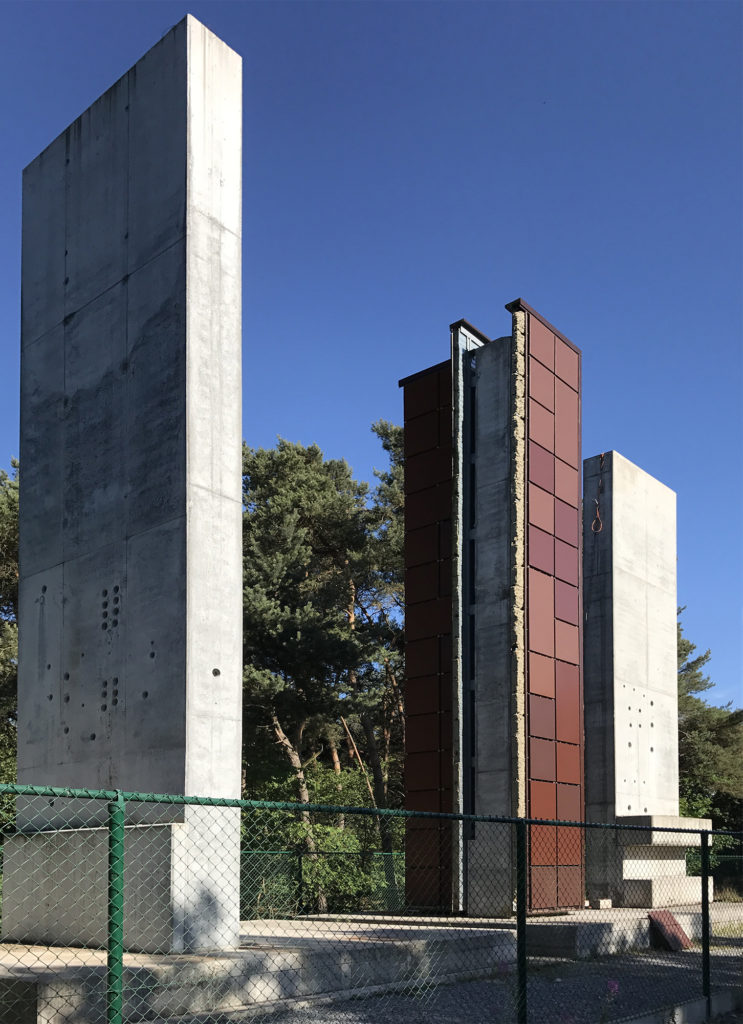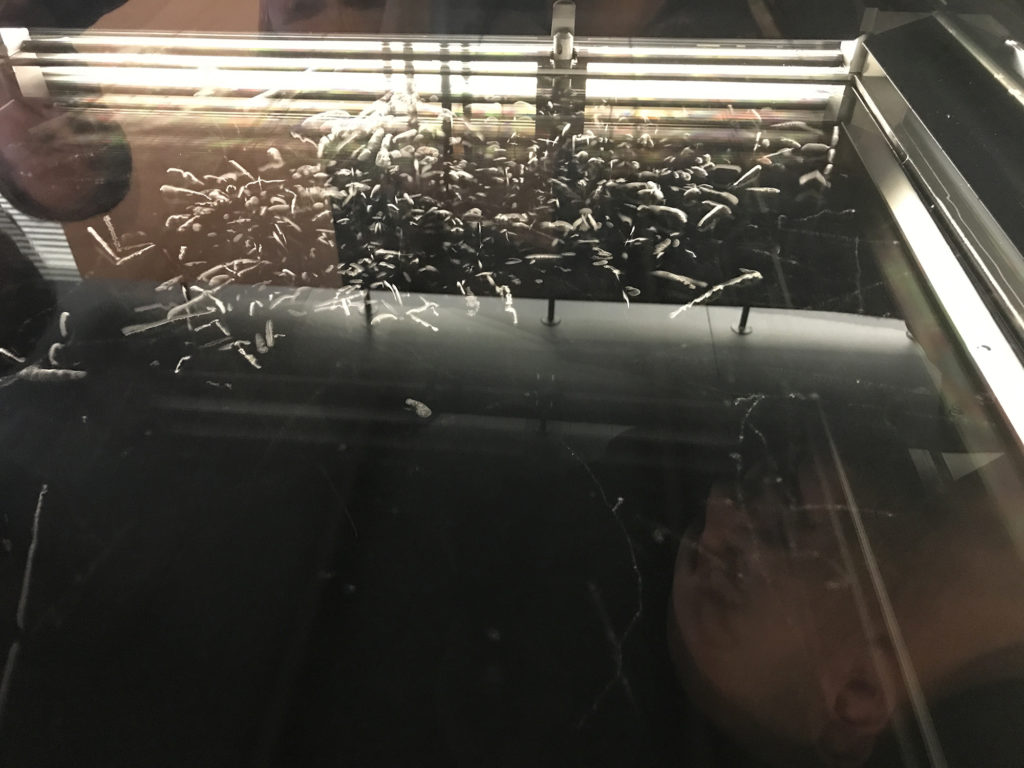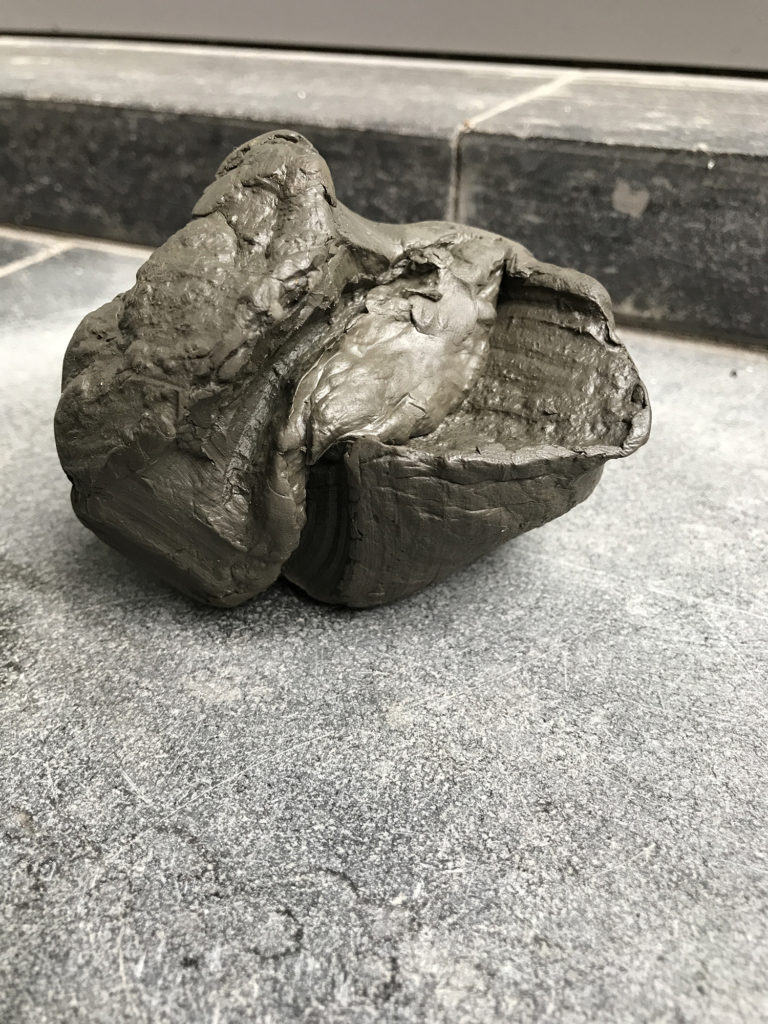Ele Carpenter. (Post-) Nuclear Anthropocene
Nuclear industry is undergoing a process of decommissioning and waste management. At the same time, a renewed interest in the ‘nuclear humanities’ is now also reaching art and curating. Curator and writer Ele Carpenter reflects on the relation of art and nuclear culture.

The Anthropocene, now a ubiquitous concept within the humanities, signals a geologic age where humans have impacted on the Earth’s climate and environment, evidenced in layers of geologic strata. Central to the discourse of the Anthropocene is the concept of the Nuclear Anthropocene referring to the way in which man-made radionuclides are released into the environment through fallout, providing a radiological time-stamp of the start of the nuclear age in 1945, with peak atomic testing in the mid-1960s. Additional radioactive markers are provided when major nuclear accidents release radioactive isotopes into the biosphere such as Three Mile Island, Chernobyl and Fukushima. In this century, the deep storage of high level radioactive waste inserted into the fossil record, will create a new geologic layer 200–500 meters below ground, for hundreds of thousands of years. A geologic repository is currently being constructed in Finland, whilst countries such as Belgium, France, Sweden and Japan have built underground research laboratories to test how radioactive waste can be stored in specific geologic layers. Radionuclides are also used to mark and measure flows in ocean currents, scan our brains, illuminate our intestines, and as a time-stamp of the formation of the earth. Uranium is as old as the earth, and its half-life dates the planet at 4.5 billion years.
‘Nuclear Culture’1 is the overarching title for a curatorial research project into contemporary visual art and nuclear culture, a necessarily long-term, cross-sector and intergenerational process. The project includes writing, field trips, presentations, roundtable discussions, exhibitions and publications. In the longer term it aims to create contexts for commissioning artists to be involved in the international and stakeholder consultation surrounding nuclear waste sites, markers and archives. If artworks are to hold knowledge for the future they need to be distributed and networked across digital and analogue platforms, sites, archives, libraries and collections. Here the curatorial challenge is how to commission art to create a resilient cross-sector knowledge network.
The Nuclear Culture project regularly brings together people from different professional and disciplinary backgrounds to share their expertise and knowledge. Feedback from participants reflects on how working with people from different disciplines provides space to: think differently; to take care over language; and to understand how we are misunderstood. The process provides an opportunity to deconstruct transferable metaphors, establish shared philosophical concepts, and deal with disciplinary alienation, and problems of negation.
In the 21st century the nuclear industry is undergoing a process of decommissioning and waste management, and as a result its material conditions are shifting into public view, perhaps even public responsibility for the first time. The industry is starting to consolidate its archives, and consider the relationship between public site markers and public archives. Once the nuclear archives move into the public domain, they can include multiple narratives, and include forms of critical enquiry and dissent.
At the same time there is a renewed interest in the ‘nuclear humanities’ within history, literature, archeology, anthropology, linguistics, philosophy, cultural theory, art history, and now – art and curating. Although there’s much work to be done to articulate how the visual arts can contribute to nuclear studies, where the artwork opens up new modes of conceptualization. Perhaps this is more clearly understood in the European Radioactive Waste Management (RWM) research networks where sociologists and philosophers work alongside engineers and nuclear physicists on the challenges of siting, building and monitoring geological repositories. The European discourse is instrumental in conceptualizing the field of nuclear humanities beyond the polarities of British nuclear politics entwined with the secrecy of its nuclear weapons programme.

The Belgium government has a political commitment to phase-out nuclear energy, and current concern focuses on the extension of the life of aging reactors, and the need to take care of radioactive waste for the future. Although Belgium doesn’t have a nuclear weapons programme, it has a colonial legacy of uranium mining in the Congo. To trace the practice of uranium mining through empire is to start to understand the global mesh of the nuclear economy, its violent exploitation of indigenous people and natures earth resources.
There’s no ‘outside’ to the nuclear economy, it pervades every aspect of capitalism and the relationship between state, military and industry – what Eisenhower coined the military industrial complex. So whilst terms such as the ‘nuclear age’ are often used to refer to the 20th century development of nuclear technology and the cold war, the nuclear anthropocene is a shift towards the post-nuclear age; a time where the nuclear is embedded in every aspect of everyday life in its electricity production, global contamination, disruption of chromosomes and production of psychic fears.
Since the inauguration of Donald Trump as President of the United States, and the re-election of Theresa May as Prime Minister of Britain, the volatility of the nuclear arms race has been brought into question with gung-ho arguments on both sides of the Atlantic for actually using nuclear weapons. Trump is easily provoked by North Korea’s recent rocket launches, and for the first time since the end of the Cold War, the escalation and threat of nuclear weapons has significantly increased. Yet the UN Treaty on the prohibition of nuclear weapons, endorsed by 122 countries in July 2017, is a huge step towards the un-invention of nuclear weapons as a strategically redundant technology.
When trying to cope with the enormity of nuclear weapons, there is something attractive about radioactive waste, the speculative philosophy, deep time scales, deferred responsibility, elaborate mythologies, and future folklore; but these underground vaults of hot vitrified waste are really being planned and built. These waste repositories will become the nuclear heritage of the future, vast sites requiring global identification on the scale of world heritage sites.
In some consultation dialogues, the general feeling seems to be that nuclear science has run-out of language and skills to solve the next set of problems. In the age of the Anthropocene ‘people’ or ‘publics’ no longer have a utopian belief in a nuclear powered future; so more complex cultural strategies are required to make sense of the continuing present, before understanding how to communicate across generations. In today’s industry, the emphasis on sustainability and intergenerational equity means that people have to solve the problems of today and not leave them for future generations; humans have to keep resources intact for the future. As nuclear materials enter public circulation, so does their representation. Inviting artists and curators to the table, provides the opportunity to deconstruct assumptions about transferable metaphors, shared philosophical concepts, and new forms of folklore and mythology.
When it comes to understanding the relationship between past, present and future, art is perhaps expert in its own temporality. Whilst the concerns of temporality might seem too abstract for a general western public, there are many examples of complex cultural knowledge surviving over millennia. Contemporary art is also part of our contemporary culture, and embodies complex meaning, which may be able to communicate into the future through a formal language. Like the Maori dance, which remembers the presence of the ocean in a now dry landscape, echoing the discovery of coral reef fossils in that very place.
All the artworks in the ‘Perpetual Uncertainty’ exhibition grapple with different aspects of the nuclear anthropocene.
The ‘Records Knowledge and Memory’ group have a dual track approach to passing on knowledge about nuclear sites to future generations. One strategy is to project knowledge into the future, in the hope that it will be visually or linguistically legible. The other strategy is a relay approach to pass on knowledge between generations, what we might think of as cultural practices. Cecile Massart (Belgium) presents both of these strategies incorporated into architectural structures and landscapes above a nuclear site. Massart’s work is all about the site: marked on maps, drawn, inscribed on the landscape, concrete marked with symbols. These architectural markers encourage people to continue to add to the site, to mark the place over generations and centuries. The proposal includes a laboratory for new forms of social organization prioritizing interdisciplinary and intergenerational knowledge sharing. Her reinvention of the marker, constantly re-interpreted within the present, is very different from the ‘permanent’ landmarks proposed by the Human Interference Task Force in the USA. Rather than trying to communicate with the deep future as a semiotic challenge, Massart’s work contends that the problem is not simply one of the past or future, but of the continuing present.
Jon Thomson & Alison Craighead (UK/Scotland) investigate understandings of geological and planetary time through the relationship between live data and the material world.2 At the core of their ‘temporary index’ artwork is a database, which drives an array of numeric counters which countdown the probabilistic decay of radioactive materials in seconds. These counters can be presented as a full array or single totem, embedded in specific sites, syndicated online, presented in an art gallery, included in nuclear archives, and preserved in museum collections.
As animated objects of contemplation, the array artwork is a representation of time that far outstrips the human life cycle and provide us with a glimpse into the vast time scales that define the universe in which we live in, but which also represent a future limit of humanity’s temporal sphere of influence. The design of the counter demonstrates how human measurement of time is a process of linguistic and pictorial language. The artwork is reconfigured to the architecture and context of each location in which it is situated, highlighting the half-lives of local sites.
At Z33 House for Contemporary Art the artists have been commissioned to create a proto-type for a totem marker for the forthcoming Category A low level waste storage site at Dessel in Belgium designed to isolate radioactive waste for 300 years. The totem in the gallery operates as a signpost to Dessel, 44 km from Hasselt, providing a marker of time, site and distance. Whilst the time-frame of the low level waste is only a few generations, it has provided as opportunity for the Belgian Radioactive Waste Management Agency NIROND/NIRAS to develop a co-design building in partnership with the local community for both the storage infrastructure and the communications center.

It is important that artists get closer to the nuclear economy, its language and aesthetics to develop informed and articulate responses within a contemporary context. To develop their artwork, Thomson and Craighead undertook field research to the HADES underground research lab in Mol in Belgium, the Horonobe underground research lab in Japan, and the low-level waste storage site at LLW Ltd Drigg in the UK.
Whilst Thomson & Craighead create a sense of the abstraction of deep time within the present, Andy Weir (UK) is making objects for a speculative future. His artwork is an ongoing research project testing proto-type models for a future marker for radioactive storage sites. The full title of the work Pazu-goo: 3D Printable Marker for a Future Posthuman Palaeoarcheologist (ca. 700 BC – 4,6 x 10 AD) describes a flexible and modifiable 3D printed object designed to be discovered in the future. Pazu-goo is a Uranium-glowstick waving version of Pazuzu, the Assyrian-Babylonian demon of contagion, epidemic and dust. The figure is proposed as a marker for the deep geological repository, addressed to the future.
Rather than designing a monumental landmark, Weir utilizes the archeology of long-lived small tokens and artefacts lost and buried in the landscape, combined with totemic belief systems to create value. Religious and secular belief systems are a significant part of the debate about nuclear semiotics and how to communicate important knowledge into the deep future (Sebeok, 1984). Whilst many acknowledge the impossibility of such a task, Weir’s project operates both philosophically and materially. It is both a conceptual proposition and an experiment to see if it is practically and politically feasible.
Weir attempts to create a thread of digital mutation through replicating the figure of Pazuzu who warns against dangers as intangible as dust and viruses. The physical mutation of the 3D model aims to highlight the invisibility and mutating force of radiation. At Bildmuseet in Sweden Andy Weir ran workshops to create glitched 3D Pazu-goo models using 3D printing. For Z33 he has created three new figures to complement the Christian belief in Saint Barbara, patron saint of mining, lightening, fire and explosion. The work is inspired by the figure of Saint Barbara placed at the top of the lift shaft entrance to the underground research laboratories at HADES in Belgium and CIEGO in France.
As the term ‘nuclear anthropocene’ enters common usage, and the uncertainty surrounding the future use of nuclear weapons comes back into the public eye, artists will continue to engage with nuclear culture. Working in partnership with nuclear agencies and sites is vital to increasing artistic knowledge and engaging wider audiences in dialogue about the future care and development of radioactive technologies and materials.
Working with other disciplines can help to broadened the horizons of the context in which we work, giving people permission to think differently, and speak about concerns that the normative culture of their field doesn’t allow space for. It can help to articulate things people already know but don’t have the language or support to describe. The arts and humanities can think holistically, they don’t need to compartmentalize research-processes and knowledge in the same way as science and engineering. At the same time these disciplines are not homogenous, there are many arts and many sciences. But industry/ research or art / science partnerships often have expectations that art might articulate what is already visible and known, whilst artists might interrogate the interplay of visibility and invisibility both materially and politically in unexpected ways.
Art continues to increase complexity by raising rather than answering questions. Working with art and artists can open up new spaces of thought, through an insistence on conceptual enquiry, which requires multiple registers of reception and dissemination. As such, it is resistant to capture as public relations. The concepts of deep time and the human time of the Anthropocene make sense in all disciplines, even if the material networks are perceived differently. The gaps in language only become apparent through in-depth dialogue with art as a critical form. The written text doesn’t provide material for collaboration because there are too many misunderstandings in the translation of interests and rhetoric.
Several decades or centuries of curatorial work is needed for the nuclear archives to move into the public domain, and to be able to include art and politics. The first step is to establish a curatorial context for the commissioning, production and dissemination of these contemporary artworks within multiple discourses, to find new ways of embedding the complexity of radioactive waste management in our past, present and future cultures.